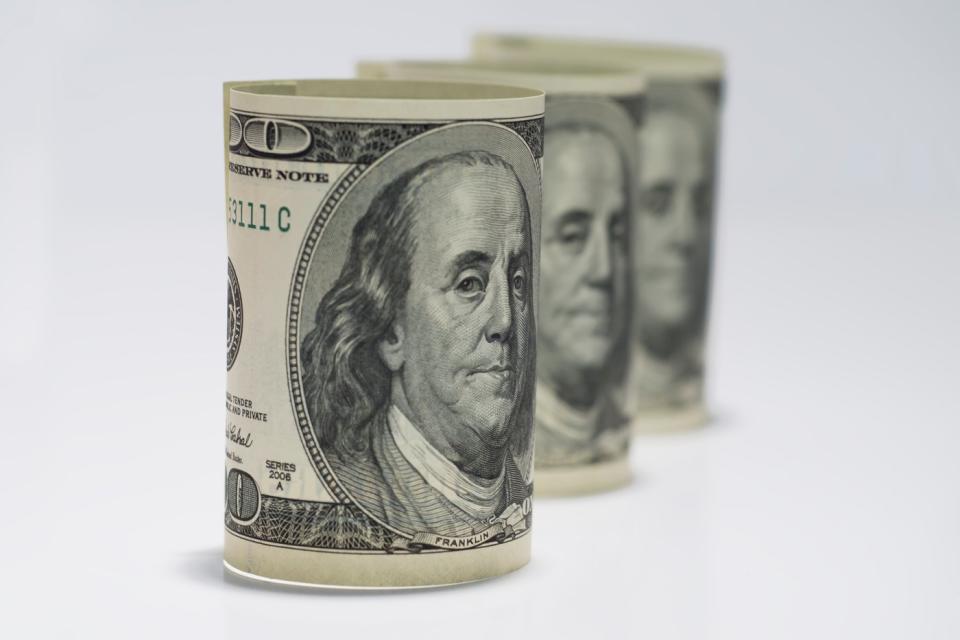Want $300 in Super Safe Dividend Income in 2024? Invest $4,175 Into the Following 3 High-Yield S&P 500 Stocks.
Wall Street offers investors an assortment of ways to make money. However, few investment strategies have proved as successful over extended periods as buying dividend stocks.
Last year, the Hartford Funds and Ned Davis Research published data showing that dividend stocks averaged an annualized return of 9.18% over the past half-century (1973-2022). By comparison, publicly traded companies that don't pay a dividend have delivered a considerably tamer annualized return of 3.95% over the same five-decade stretch.
Dividend stocks running circles around non-payers isn't a surprise. Companies that consistently pay a dividend to their shareholders are almost always profitable and time-tested.

The most challenging aspect of investing for income seekers is figuring out which dividend stocks to buy. Considering that the benchmark S&P 500 (SNPINDEX: ^GSPC) is comprised of some of the largest time-tested businesses, it's a smart place to start your research.
As of Jan. 12, more than two dozen S&P 500 components were yielding in excess of 5% -- three of which stand out for all the right reasons. If you want to generate $300 in super safe dividend income in 2024, simply invest $4,175 (split equally, three ways) into the following three high-yield S&P 500 stocks, which sport an average yield of 7.2%!
Verizon Communications: 6.9% yield
The first high-octane income stock in the benchmark S&P 500 that can help pad your pocketbook in the new year is telecom company Verizon Communications (NYSE: VZ). Despite bouncing decisively off of its October 2023 low, Verizon is still yielding nearly 7%, which is close to an all-time high.
Verizon faced something of a double whammy last year. First, rising interest rates made the prospect of future debt-financed acquisitions less appealing. It also meant refinancing the company's existing debt could be costlier.
The other issue for Verizon was the July report from The Wall Street Journal that suggested legacy telecom providers could face sizable monetary and/or environmental costs tied to the replacement of lead-sheathed cables still in use. Verizon has noted that lead-clad cables make up only a small percentage of its network.
Further, any liability would almost certainly be determined by the U.S. court system, which is notoriously slow. Long story short, the WSJ story looks to be a near-term nothingburger for investors.
What isn't a nothingburger is the modest but steady growth Verizon is enjoying from the 5G revolution. Upgrading its network to handle faster download speeds lifted wireless revenue by nearly 3% in the September-ended quarter and has been pivotal in sustaining a historically low churn rate.
Perhaps even more important is the surge in broadband net additions Verizon has observed following its purchase of mid-band spectrum in 2021. The ability to offer 5G internet speeds to businesses and residential customers led to 434,000 net additions in the third quarter and marked the fourth-consecutive quarter of at least 400,000 net adds. Broadband is a source of predictable cash flow for the company and the perfect dangling carrot to entice users to bundle their services.
Something else worth noting is that wireless service and internet access have effectively become basic necessities. Consumers might cancel their cable subscriptions to save a few dollars but are highly unlikely to go without internet access or wireless service. This makes Verizon's operating cash flow highly predictable from one year to the next.
Although Verizon isn't going to knock your socks off with its growth rate, a forward price-to-earnings (P/E) ratio of 8 provides a safe floor with reasonable upside, as the operating benefits of the 5G revolution continue to be felt.
Altria Group: 9.48% yield
The second supercharged dividend stock in the S&P 500 that can help you bring home $300 in super safe dividend income in 2024 from a starting investment of $4,175 (split three ways) is tobacco giant Altria Group (NYSE: MO). Not only is Altria the highest-yielding S&P 500 component at nearly 9.5%, but it's raised its payout 58 times over the past 54 years.
The biggest challenge for Altria is overcoming a shrinking percentage of adult smokers in the United States. Based on data from the Centers for Disease Control and Prevention, the adult cigarette smoking rate has fallen from around 42% in the mid-1960s to just 11.5% as of 2021. With the public aware of the potential health risks associated with long-term tobacco use, it's unlikely this figure will rebound anytime soon.
Although a shrinking pool of smokers isn't ideal, it's not damning to Altria's operating model.
One thing Altria has working in its favor is that tobacco products contain nicotine. Since nicotine is an addictive chemical, Altria usually has no trouble passing along price increases that more than offset any decline in cigarette shipments.
To add to the above, Altria's premium cigarette brand Marlboro accounted for a greater-than-42% share of the cigarette market, as of the end of September. Controlling such a prominent piece of the pie gives the company more leeway to increase its prices without driving away its loyal customers.
However, it's Altria Group's evolution as a business that can make investors meaningfully richer. For example, the acquisition of electronic-vapor company NJOY Holdings for $2.75 billion in June gives the company access to the fast-growing e-vape market.
While Altria's investment in Juul didn't pan out, it's not making the same mistake twice. NJOY has landed a half-dozen marketing granted orders (MGOs) from the U.S. Food and Drug Administration for its products. MGOs are authorizations that allow e-vapor products to be sold. The overwhelming majority of e-vape products lack MGOs and could be pulled from retail shelves at any time.
With Altria generating bountiful cash flow from its traditional tobacco operations and expected to deliver meaningful long-term growth from its burgeoning smokeless segment, a forward P/E ratio of 8 appears to be a phenomenal deal.

Realty Income: 5.23% yield
The third high-yield S&P 500 stock that can help you generate $300 in super safe dividend income in 2024 from an initial investment of $4,175 (split equally across three stocks) is retail real estate investment trust (REIT) Realty Income (NYSE: O). The REIT pays its dividend monthly and has increased its payout 123 times (and for 105 consecutive quarters) since becoming a public company in 1994.
The single largest risk for retail REITs is a recession. If the U.S. economy contracts, it not only saps the lease-pricing power of retail REITs, but there's a higher risk of rental delinquencies. I mention this risk because a couple of money-based metrics and predictive indicators suggest a recession is a real possibility for the U.S. economy in 2024.
The good news for Realty Income is that it has a couple of ways to mitigate recessionary risks while continuing to steadily grow its funds from operations (FFO).
The composition of Realty Income's nearly 13,300-property commercial real estate (CRE) portfolio is a big reason for its ongoing success. It has more than 1,300 different renters from 85 industries.
Most importantly, 91% of its total rent collected derives from businesses that are deemed "resilient to economic downturns and/or isolated from e-commerce pressures." Generating more than a third of its annualized contractual rent from businesses that provide basic-need goods and services -- such as grocery stores, convenience stores, dollar stores, and drug stores -- ensures highly predictable FFO.
Additionally, Realty Income is diversifying its CRE portfolio beyond retail. It's in the process of acquiring Spirit Realty Capital in an all-stock deal valued at $9.3 billion that'll push the combined company into new industries. Further, Realty Income undertook two deals in the gaming industry over the past two years.
Realty Income is currently valued at 13.8 times consensus cash flow estimates in 2024. This represents a decade-low multiple to cash flow and is 27% below its average price-to-cash-flow multiple over the previous five years.
Should you invest $1,000 in Verizon Communications right now?
Before you buy stock in Verizon Communications, consider this:
The Motley Fool Stock Advisor analyst team just identified what they believe are the 10 best stocks for investors to buy now... and Verizon Communications wasn't one of them. The 10 stocks that made the cut could produce monster returns in the coming years.
Stock Advisor provides investors with an easy-to-follow blueprint for success, including guidance on building a portfolio, regular updates from analysts, and two new stock picks each month. The Stock Advisor service has more than tripled the return of S&P 500 since 2002*.
*Stock Advisor returns as of January 8, 2024
Sean Williams has no position in any of the stocks mentioned. The Motley Fool has positions in and recommends Realty Income. The Motley Fool recommends Verizon Communications. The Motley Fool has a disclosure policy.
Want $300 in Super Safe Dividend Income in 2024? Invest $4,175 Into the Following 3 High-Yield S&P 500 Stocks. was originally published by The Motley Fool
